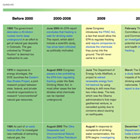| Before 2000 |
2000-2008 |
2009 |
2010 |
2011 |
|
1969 The government
detonates a 43-kiloton nuclear bomb deep underground in an effort to get at
natural gas deposits in Colorado. The gas unlocked by “Project Rulison” is
deemed too radioactive to use.
|
June 2004 An EPA report
concludes that fracking is safe for drinking water. The
report, which didn’t include a scientific study,
has since been criticized as politically motivated.
|
June Congress introduces
the FRAC Act, a law that would allow the EPA to regulate fracking and
require companies to disclose the chemicals they pump into the ground. The bill never came to a vote.
|
February The House Committee on Energy
and Commerce
launches an investigation into the potential environmental and health
impacts of fracking.
|
March The FRAC Act mandating more oversight is reintroduced into the House and
Senate. It
is still in committee.
|
|
1976 In response to energy shortages,
the DOE launches the
Eastern Gas Shales Project, a joint research project between state,
federal, and private industrial organizations to research “unconventional”
natural gas resources.
|
August 2005 Congress passes a lawprohibiting the EPA
from regulating fracking under the Safe Drinking Water Act. In most other cases the law dictates what chemicals can be injected underground.
|
August In response to complaints of
drinking water contamination, the EPA begins investigating
wells in drilling areas of Pavillion, Wyoming. Initial testing finds at least
three water wells that contain a chemical used for fracking.
|
March The EPA
launches a study looking at the impacts of fracking on drinking
water nationwide. The final report is due out in
2014.
|
April Congressional Democrats
release a report stating that over the past few years gas drillers have
injected millions of gallons of fluids containing potentially toxic
chemicals into the ground.
|
|
1986 As part of an
early federal effort to investigate new methods of extracting natural gas,
the Department of Energy sponsors
the drilling of a 2,000-foot horizontal well in the Devonian shales of
Wayne County, WV.
|
August 2005 The
Ultra-Deepwater and Unconventional Natural Gas and Other Petroleum Resources
Research Program is established to develop technologies to increase
national oil and gas production and reduce dependency on imports.
|
October The
Obama administration rescinds the 2007 memo that loosened restrictions on air pollution caused by drilling.
|
December
The Department of the Interior holds a forum to discuss the impact of
current drilling practices and to consider a policy requiring companies to
disclose the chemicals they use for fracking. President Obama has spoken in support of such a policy, but no official rules have been implemented.
|
May A federal panel releases a
report concluding that
current fracking regulations may not be enough to protect the environment
and public health. That same month, Congress introduces the BREATHE
act, which would give the EPA power to regulate air pollution from
fracking. It has yet to pass.
|
|
1994 The Legal Environmental Assistance Foundation uses the Safe Water Drinking Act to challenge the EPA’s decision not to regulate fracking in Alabama. The EPA maintains that it is under no such legal requirement. Two years later, the case reaches a federal appeals court which rules against the EPA, saying the agency is in fact required to regulate fracking (at least in Alabama). The decision prompts an effort to exempt fracking from regulation, and in 2005, an exemption is passed by Congress.
|
January 2007 A Bush administration memo effectively loosens the limits on air pollution from many natural gas wells.
|
December In a controversial decision, the Bureau of Land
Management
approves gas drilling within a three mile buffer zone of a radioactive
Colorado site, the home of the 1960’s nuclear test Project Rulison.
|
|
July 2011 The EPA proposes a set of regulations to reduce
harmful air pollution from oil and natural gas production,
specifically targeting compounds released by fracking. The regulations have not yet been adopted.
|
|
|
October 2008 The Department of Energy funds
AltaRock, a project to
extract renewable energy from hot bedrock by fracking more than two miles deep. The test, which a year later the Obama administration makes its first major geothermal venture, is cancelled quickly due to, among other things, concerns about causing an earthquake.
|
|
|
October The EPA
announces a plan to issue new national rules for fracking wastewater. The process is still in its early stages, and the EPA is currently simply soliciting input.
|
|
|
|
|
|
November In response to
a petition by environmental groups, the EPA agrees to
develop rules requiring companies to test and submit data on the chemicals
they use for fracking. Again the rules are not yet set.
|
|
|
|
|
|
December An EPA draft
report concludes that contaminants in Pavillion, Wyoming most likely seeped
up from gas wells,
scientifically linking water contamination to fracking for the first
time.
|













